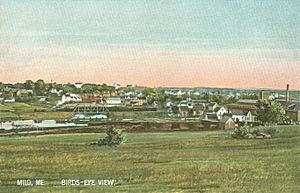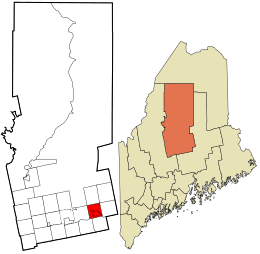Milo, Maine facts for kids
Quick facts for kids
Milo, Maine
|
|
|---|---|

Bird's-eye view c. 1910
|
|

Location in Piscataquis County and the state of Maine.
|
|
| Country | United States |
| State | Maine |
| County | Piscataquis |
| Incorporated | 1823 |
| Area | |
| • Total | 33.96 sq mi (87.96 km2) |
| • Land | 32.98 sq mi (85.42 km2) |
| • Water | 0.98 sq mi (2.54 km2) |
| Elevation | 322 ft (98 m) |
| Population
(2020)
|
|
| • Total | 2,251 |
| • Density | 26.4/sq mi (10.2/km2) |
| Time zone | UTC-5 (Eastern (EST)) |
| • Summer (DST) | UTC-4 (EDT) |
| ZIP code |
04463
|
| Area code(s) | 207 |
| FIPS code | 23-46020 |
| GNIS feature ID | 0582597 |
| Website | https://www.trcmaine.org/community/milo |
Milo is a town located in Piscataquis County, Maine, in the United States. In 2020, about 2,251 people lived there. The town includes a smaller area called Derby.
Milo is nestled in a valley where the Piscataquis, Sebec, and Pleasant Rivers meet. It's surrounded by the foothills of the Longfellow Mountains. This area is a great starting point for many outdoor adventures. You can go hunting, fishing, hiking, and boating. Popular spots nearby include Schoodic, Seboeis, and Sebec Lakes. You can also visit Mount Katahdin and the wild areas of Baxter State Park and the Katahdin Woods and Waters National Monument. Don't forget Katahdin Iron Works and Gulf Hagas!
Contents
History of Milo
The area now known as Milo was first called Township Number 3. It was part of a larger land division. Benjamin Sargent and his son, Theophilus, were the first settlers. They came from Methuen, Massachusetts, on May 2, 1802.
On January 21, 1823, the community officially became a town. It was named Milo after Milo of Croton, a famous athlete from ancient Greece. Milo quickly became a center for trade. Trafton's Falls provided water power for early businesses. In 1823, Winborn A. Swett built a dam and the first sawmill. Thomas White later added a mill for processing wool. A larger wool factory was built in 1842, but it burned down six years later.
The railroad arrived in Milo between 1868 and 1869. This helped Milo grow into a small mill town. The town produced many wood products. In 1879, a company built a factory to make excelsior, which is thin wood shavings used for packing. Later, in 1901–1902, the American Thread Company built a factory there. They even had a small industrial railway to move materials.
Derby Village: A Railroad Town
The early railroads, Bangor & Piscataquis and Bangor & Katahdin Iron Works, met at a place called Milo Junction. When these railroads joined to form the Bangor and Aroostook Railroad, Milo Junction became the company town of Derby. It had one of the largest railroad car repair shops in New England.
In 1906, the railroad invested a lot of money in brick buildings. These included an office, a planing mill, and a large enginehouse. There was also a huge car shop connected by a transfer table. This table could move train cars back and forth for repairs.
The railroad also built homes for its workers. At first, there was a 45-room hotel for single workers. There were also 46 homes for married workers. These homes had modern features like bathrooms, hot water, and electric lights. The village grew to include stores and 72 identical employee houses. These houses were sold by the railroad in 1959. The hotel later became a community center.
Downtown Fire in 2008
On September 14, 2008, a fire damaged several buildings in downtown Milo. The fire spread quickly because the buildings were old and close together. Fire departments from Milo and nearby towns worked together to put out the fire. Luckily, no one was hurt.
Geography of Milo
Milo covers about 33.96 square miles (87.96 km2) of land and water. Most of this area, about 32.98 square miles (85.42 km2), is land. The town is located where the Sebec River and the Piscataquis River flow together. The Pleasant River also runs through the town. Because of these three rivers, Milo is sometimes called the "Town of Three Rivers." Milo is also very close to the exact center of the state of Maine.
Milo's Climate
Milo has a climate with big changes in temperature throughout the year. Summers are warm to hot, and winters are cold. This type of climate is known as a humid continental climate.
Population Information
| Historical population | |||
|---|---|---|---|
| Census | Pop. | %± | |
| 1830 | 381 | — | |
| 1840 | 756 | 98.4% | |
| 1850 | 932 | 23.3% | |
| 1860 | 959 | 2.9% | |
| 1870 | 938 | −2.2% | |
| 1880 | 934 | −0.4% | |
| 1890 | 1,029 | 10.2% | |
| 1900 | 1,150 | 11.8% | |
| 1910 | 2,556 | 122.3% | |
| 1920 | 2,894 | 13.2% | |
| 1930 | 2,912 | 0.6% | |
| 1940 | 3,000 | 3.0% | |
| 1950 | 2,898 | −3.4% | |
| 1960 | 2,756 | −4.9% | |
| 1970 | 2,572 | −6.7% | |
| 1980 | 2,624 | 2.0% | |
| 1990 | 2,600 | −0.9% | |
| 2000 | 2,383 | −8.3% | |
| 2010 | 2,340 | −1.8% | |
| 2020 | 2,251 | −3.8% | |
| U.S. Decennial Census | |||
Milo's Population in 2010
In 2010, Milo had 2,340 people living in 1,034 households. About 645 of these were families. The town had about 71.0 inhabitants per square mile (27.4/km2) people per square mile. There were 1,274 housing units in total.
Most of the people in Milo (97.2%) were White. Small percentages were African American, Native American, or Asian. About 0.9% of the population identified as Hispanic or Latino.
In Milo, 26.2% of households had children under 18. About 45.9% were married couples. The average household had 2.26 people. The average family had 2.78 people.
The average age in Milo was 44.7 years old. About 21.4% of residents were under 18. About 19.6% were 65 or older. The town's population was almost evenly split between males (48.8%) and females (51.2%).
Places to Visit in Milo
Milo has several interesting places to explore:
- Milo Historical Society & Museum
- Harrigan Learning Center and Museum
- Milo-Brownville & Points North Visitors Center
- Milo Public Library
- Veterans Park
- Doble Park
- Maine ITS Snowmobile Trails – ITS 82 and 83 (great for winter fun!)
- ATV trails (for off-road adventures)
Education in Milo
Students in Milo attend these schools:
- Penquis Valley High School
- Penquis Valley Middle School
- Milo Elementary
- Brownville Elementary
Notable People from Milo
Some well-known people have come from Milo:
- Wilder Stevens Metcalf: A U.S. Army major general and a member of the Kansas Senate.
- Oswald Tippo: A famous botanist and educator.
- Edward Youngblood: A state legislator.
Images for kids
See also
 In Spanish: Milo (Maine) para niños
In Spanish: Milo (Maine) para niños





